Development of Home Energy Management Scheme for a Smart Grid Community
Abstract
1. Introduction
- A computationally efficient simulation model for HEM is developed using the C++ software package.
- The proposed model enables a power-sharing strategy in a community being assessed sequentially.
- The power-sharing technique with the proposed model saves energy cost up to 35% and 45% compared to conventional techniques.
- Mathematical modelling is developed to facilitate extensive analysis.
2. Problem Description
Smart Grid Architecture
- Time-of-use pricing information can acquire from the distant consumer price indications.
- Customer’s energy use information can accumulate, store and notify any particular time intervals or real-time.
- A detailed load patterns can develop the energy management process effectively.
- Smart meter can locate and identify the outages of any particular consumer by sharing a control message throughout the entire energy community.
- Power circuit can open or close over a long distance.
- Feasible to identify line losses and stealing exposure.
3. System Modeling
3.1. System Components
3.1.1. Solar Generator
3.1.2. Wind Generator
3.1.3. Backup Battery Storage Systems (BBSS)
3.1.4. Loads and Utility Grid
3.1.5. Mathematical Modeling of a Smart Home for the Proposed Power-Sharing Algorithm
3.2. The Proposed Algorithm and Simulations
The Proposed Power-Sharing Algorithm (PSA)
4. Simulation Results
4.1. Case Study
- Scenario 1: Residences with local utility support only;
- Scenario 2: Residences with local utility support and RESs;
- Scenario 3: Residences with local utility support, RESs and BBSS.
4.1.1. Case I
4.1.2. Case II
4.1.3. Case III
4.2. Discussion
4.3. Case Comparison
5. Conclusions
Author Contributions
Funding
Conflicts of Interest
Nomenclature
| SG | smart grid | pW | Wind power |
| SM | smart meter | ETHA | total home appliances |
| HEMS | home energy management scheme | EL | lighting load |
| PDAU | power data aggregator unit | EWM | power by washing machine |
| DSM | demand-side management | WR | power taken by refrigerator |
| PSA | power-sharing algorithm | EC | power taken by computer |
| HANs | home area networks | EDW | power taken by dishwasher |
| SMA | smart metering architecture | EH | power taken by heater |
| DSO | distribution system operator | EBB | backup battery storage |
| RESs | renewable energy sources | EEE | users extra energy |
| EMS | energy management system | EEEC | users extra energy cost |
| ESS | energy storage system | PUC | utility company |
| SI | solar irradiation | PUP | utility price |
| PV | photovoltaic | CT | total number of community |
| PwT | total wind power | RUT | total number of residential users |
| PsT | total solar power | ETUE | total users energy |
| BLo | initial battery energy level | ETUEC | total users energy cost |
| BLmax | maximum battery energy level | HTNH | total number of hours |
| BLmin | minimum battery energy level | DTND | total number of days |
| EB | battery storage | pTSPD | total satisfied power demand |
| pS | solar power | IT | total number of iteration |
| REM | residence energy management | ECE | cost of energy |
| BCSB | capacity of smart battery |
Appendix A
| Algorithm A1: Power-Sharing Algorithm (PSA) | |
| 1: | Initialization. |
| 2: | Load data. |
| 3: | Start simulation. |
| 4: | Iteration. |
| 5: | Generate random values. |
| 6: | if user power ≥ battery power then |
| 7: | Charge user battery. |
| 8: | Otherwise, the user battery is the maximum. |
| 9: | end if |
| 10: | else if found healthy battery then |
| 11: | Charge user battery. |
| 12: | Otherwise, search for another healthy battery. |
| 13: | end else if |
| 14: | if all power supply off then |
| 15: | Use a backup battery storage |
| 16: | Otherwise, use the user battery. |
| 17: | end if |
| 18: | Evaluate energy & prices. |
| 19: | Evaluate satisfied power demand. |
| 20: | repeat step 4 |
| 21: | until iteration ≥ 10 |
| 22: | Stop simulation |
References
- Farrokhifar, M.; Momayyezi, F.; Sadoogi, N.; Safari, A. Real-time based approach for intelligent building energy management using dynamic price policies. Sustain. Cities Soc. 2018, 37, 85–92. [Google Scholar] [CrossRef]
- Sharifi, A.H.; Maghouli, P. Energy management of smart homes equipped with energy storage systems considering the PAR index based on real-time pricing. Sustain. Cities Soc. 2019, 45, 579–587. [Google Scholar] [CrossRef]
- Sheikhi, A.; Rayati, M.; Ranjbar, A.M. Demand side management for a residential customer in multi-energy systems. Sustain. Cities Soc. 2016, 22, 63–77. [Google Scholar] [CrossRef]
- Hossain, M.A.; Pota, H.R.; Squartini, S.; Zaman, F.; Guerrero, J.M. Energy scheduling of community microgrid with battery cost using particle swarm optimisation. Appl. Energy 2019, 254, 113723. [Google Scholar] [CrossRef]
- Lezama, F.; Soares, J.; Canizes, B.; Vale, Z. Flexibility management model of home appliances to support DSO requests in smart grids. Sustain. Cities Soc. 2020, 55, 102048. [Google Scholar] [CrossRef]
- Rahmani-Andebili, M. Scheduling deferrable appliances and energy resources of a smart home applying multi-time scale stochastic model predictive control. Sustain. Cities Soc. 2017, 32, 338–347. [Google Scholar] [CrossRef]
- Yigit, K.; Acarkan, B. A new electrical energy management approach for ships using mixed energy sources to ensure sustainable port cities. Sustain. Cities Soc. 2018, 40, 126–135. [Google Scholar] [CrossRef]
- Abushnaf, J.; Rassau, A.; Górnisiewicz, W. Impact of dynamic energy pricing schemes on a novel multi-user home energy management system. Electr. Power Syst. Res. 2015. [Google Scholar] [CrossRef]
- Reynolds, J.; Rezgui, Y.; Hippolyte, J.L. Upscaling energy control from building to districts: Current limitations and future perspectives. Sustain. Cities Soc. 2017, 35, 816–829. [Google Scholar] [CrossRef]
- Perri, C.; Giglio, C.; Corvello, V. Smart users for smart technologies: Investigating the intention to adopt smart energy consumption behaviors. Technol. Forecast. Soc. Chang. 2020, 155, 119991. [Google Scholar] [CrossRef]
- Liu, X.; Wang, Q.; Wang, W. Evolutionary Analysis for Residential Consumer Participating in Demand Response Considering Irrational Behavior. Energies 2019, 12, 3727. [Google Scholar] [CrossRef]
- López, J.M.G.; Pouresmaeil, E.; Cañizares, C.A.; Bhattacharya, K.; Mosaddegh, A.; Solanki, B.V. Smart Residential Load Simulator for Energy Management in Smart Grids. IEEE Trans. Ind. Electron. 2019, 66, 1443–1452. [Google Scholar] [CrossRef]
- Haider, H.T.; See, O.H.; Elmenreich, W. A review of residential demand response of smart grid. Renew. Sustain. Energy Rev. 2016, 59, 166–178. [Google Scholar] [CrossRef]
- Karmaker, A.K.; Rahman, M.M.; Hossain, M.A.; Ahmed, M.R. Exploration and corrective measures of greenhouse gas emission from fossil fuel power stations for Bangladesh. J. Clean. Prod. 2020, 244, 118645. [Google Scholar] [CrossRef]
- Beaudin, M.; Zareipour, H. Home energy management systems: A review of modelling and complexity. Renew. Sustain. Energy Rev. 2015, 45, 318–335. [Google Scholar] [CrossRef]
- Hossain, M.A.; Pota, H.R.; Squartini, S.; Zaman, F.; Muttaqi, K.M. Energy management of community microgrids considering degradation cost of battery. J. Energy Storage 2019, 22, 257–269. [Google Scholar] [CrossRef]
- Di Giorgio, A.; Pimpinella, L. An event driven Smart Home Controller enabling consumer economic saving and automated Demand Side Management. Appl. Energy 2012, 96, 92–103. [Google Scholar] [CrossRef]
- Qayyum, F.A.; Naeem, M.; Khwaja, A.S.; Anpalagan, A.; Guan, L.; Venkatesh, B. Appliance Scheduling Optimization in Smart Home Networks. IEEE Access 2015, 3, 2176–2190. [Google Scholar] [CrossRef]
- Erol-Kantarci, M.; Mouftah, H.T. Wireless sensor networks for cost-efficient residential energy management in the smart grid. IEEE Trans. Smart Grid 2011, 2, 314–325. [Google Scholar] [CrossRef]
- Mahmood, A.; Khan, I.; Razzaq, S.; Najam, Z.; Khan, N.A.; Rehman, M.A.; Javaid, N. Home appliances coordination scheme for energy management (HACS4EM) using wireless sensor networks in smart grids. Procedia Comput. Sci. 2014, 32, 469–476. [Google Scholar] [CrossRef]
- Smale, R.; Spaargaren, G.; van Vliet, B. Householders co-managing energy systems: Space for collaboration? Build. Res. Inf. 2019, 47, 585–597. [Google Scholar] [CrossRef]
- Karmaker, A.K.; Ahmed, M.R.; Hossain, M.A.; Sikder, M.M. Feasibility assessment & design of hybrid renewable energy based electric vehicle charging station in Bangladesh. Sustain. Cities Soc. 2018, 39, 189–202. [Google Scholar] [CrossRef]
- Alam, M.S.; Abido, M.A.Y.; El-Amin, I. Fault Current Limiters in Power Systems: A Comprehensive Review. Energies 2018, 11, 1025. [Google Scholar] [CrossRef]
- Hossain, M.A.; Pota, H.R.; Squartini, S.; Abdou, A.F. Modified PSO algorithm for real-time energy management in grid-connected microgrids. Renew. Energy 2019, 136, 746–757. [Google Scholar] [CrossRef]
- Ur Rashid, M.M.; Hasan, M.M. Simulation based energy and cost optimization for home users in a community smart grid. Int. J. Renew. Energy Res. 2018, 8, 1281–1287. [Google Scholar]
- Lior, N. Sustainable energy development: The present (2009) situation and possible paths to the future. Energy 2010, 35, 3976–3994. [Google Scholar] [CrossRef]
- McDaniel, P.; McLaughlin, S. Security and privacy challenges in the smart grid. IEEE Secur. Priv. 2009, 7, 75–77. [Google Scholar] [CrossRef]
- Zipperer, A.; Aloise-Young, P.A.; Suryanarayanan, S.; Roche, R.; Earle, L.; Christensen, D.; Bauleo, P.; Zimmerle, D. Electric energy management in the smart home: Perspectives on enabling technologies and consumer behavior. Proc. IEEE 2013, 101, 2397–2408. [Google Scholar] [CrossRef]
- Deng, R.; Yang, Z.; Chow, M.Y.; Chen, J. A survey on demand response in smart grids: Mathematical models and approaches. IEEE Trans. Ind. Inform. 2015, 11, 570–582. [Google Scholar] [CrossRef]
- Yang, Z.; Chen, Y.X.; Li, Y.F.; Zio, E.; Kang, R. Smart electricity meter reliability prediction based on accelerated degradation testing and modeling. Int. J. Electr. Power Energy Syst. 2014, 56, 209–219. [Google Scholar] [CrossRef]
- Xiao, W.; Lind, M.G.J.; Dunford, W.G.; Capel, A. Real-time identification of optimal operating points in photovoltaic power systems. IEEE Trans. Ind. Electron. 2006, 53, 1017–1026. [Google Scholar] [CrossRef]
- Kaabeche, A.; Belhamel, M.; Ibtiouen, R. Sizing optimization of grid-independent hybrid photovoltaic/wind power generation system. Energy 2011, 36, 1214–1222. [Google Scholar] [CrossRef]
- Justus, C.G. Wind energy statistics for large arrays of wind turbines (New England and Central U.S. Regions). Sol. Energy 1978, 20, 379–386. [Google Scholar] [CrossRef]
- Rehman, S.; Al-Abbadi, N.M. Wind shear coefficients and energy yield for Dhahran, Saudi Arabia. Renew. Energy 2007, 32, 738–749. [Google Scholar] [CrossRef]
- Borowy, B.S.; Salameh, Z.M. Optimum Photovoltaic Array Size for a Hybrid Wind/PV System. IEEE Trans. Energy Convers. 1994, 9, 482–488. [Google Scholar] [CrossRef]
- Farrugia, R.N. The wind shear exponent in a Mediterranean island climate. Renew. Energy 2003, 28, 647–653. [Google Scholar] [CrossRef]
- Mohsenian-Rad, A.H.; Wong, V.W.S.; Jatskevich, J.; Schober, R. Optimal and autonomous incentive-based energy consumption scheduling algorithm for smart grid. In Proceedings of the Innovative Smart Grid Technologies Conference, ISGT 2010, Gothenburg, Sweden, 22 March 2010. [Google Scholar]
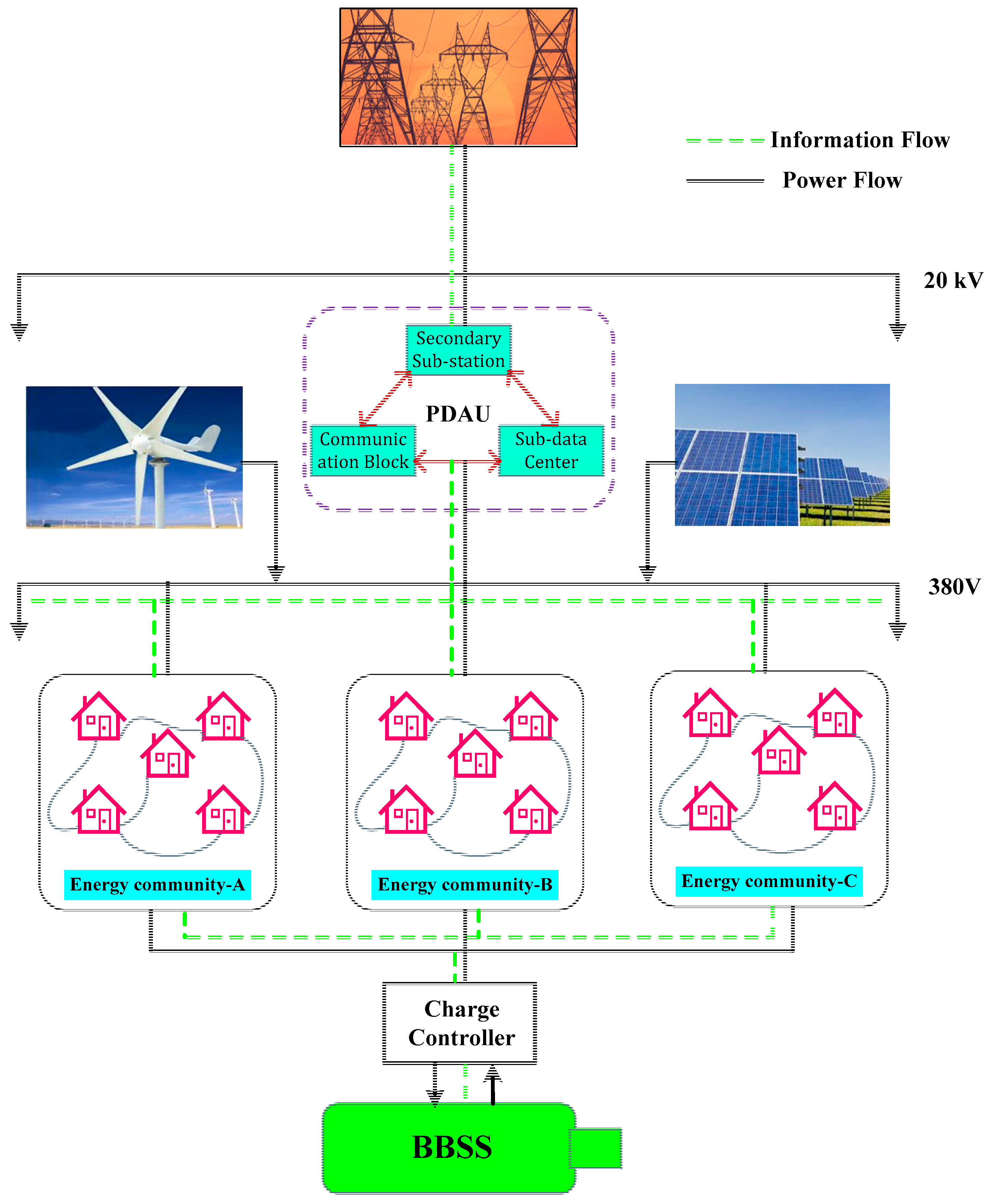


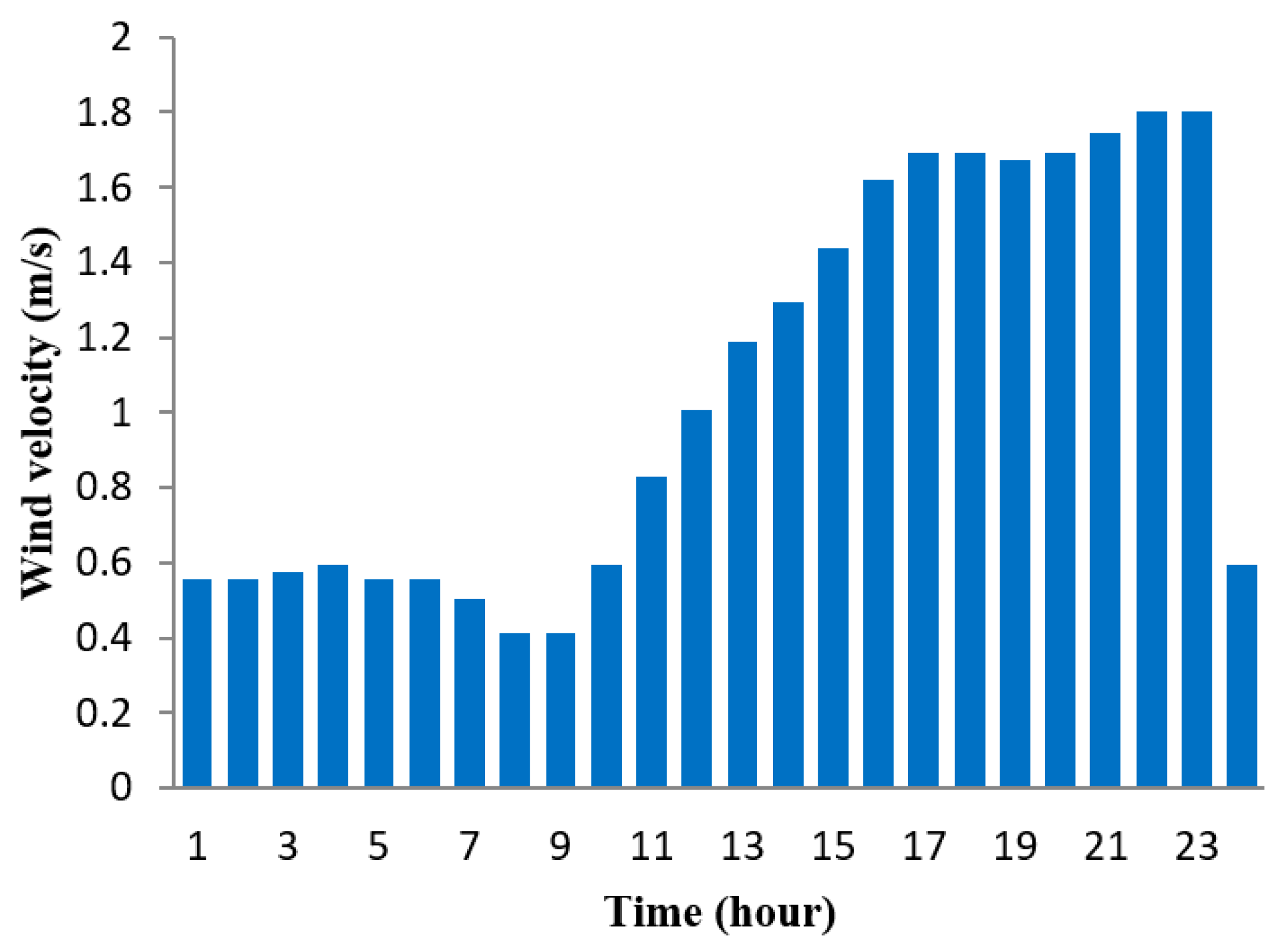




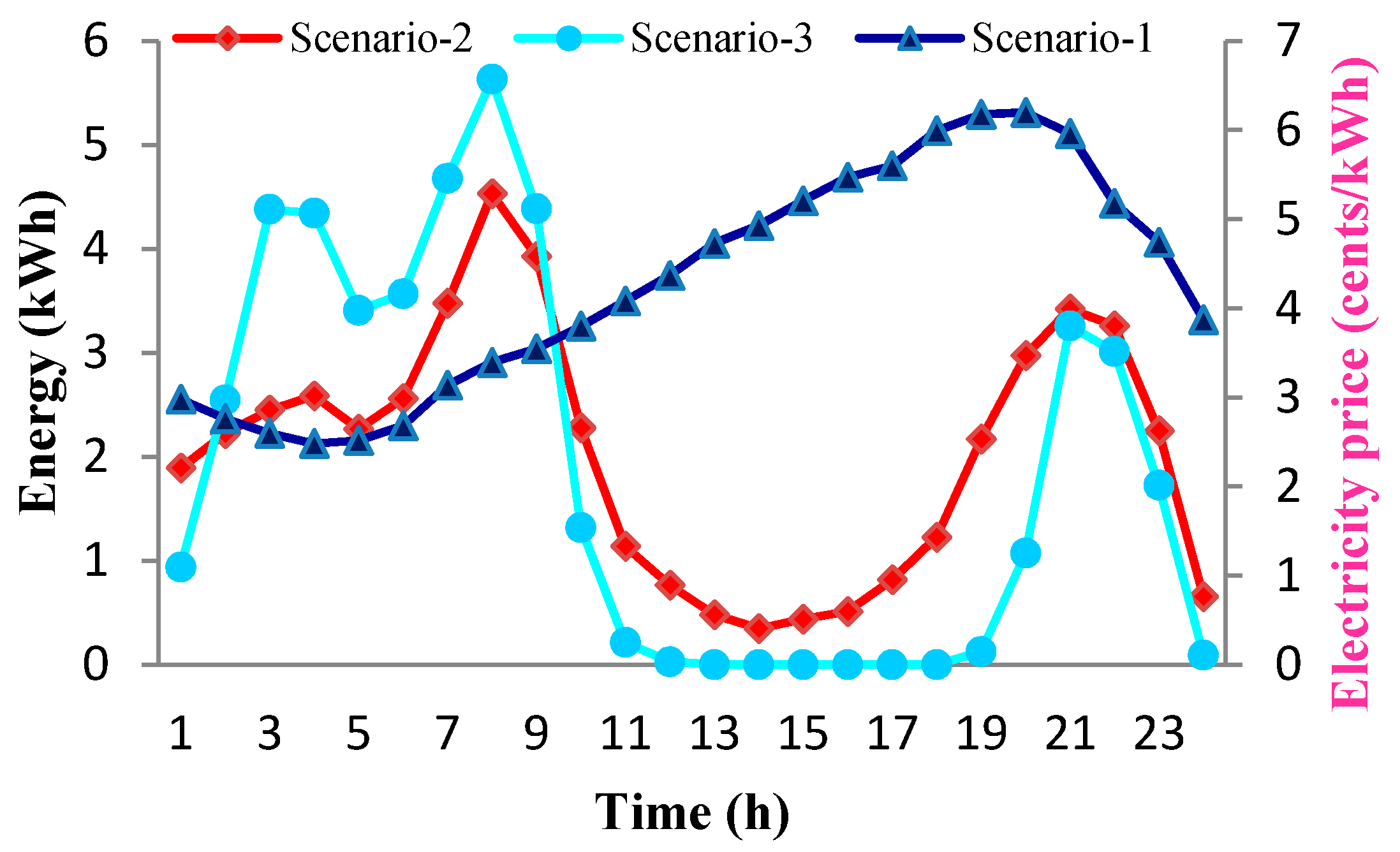


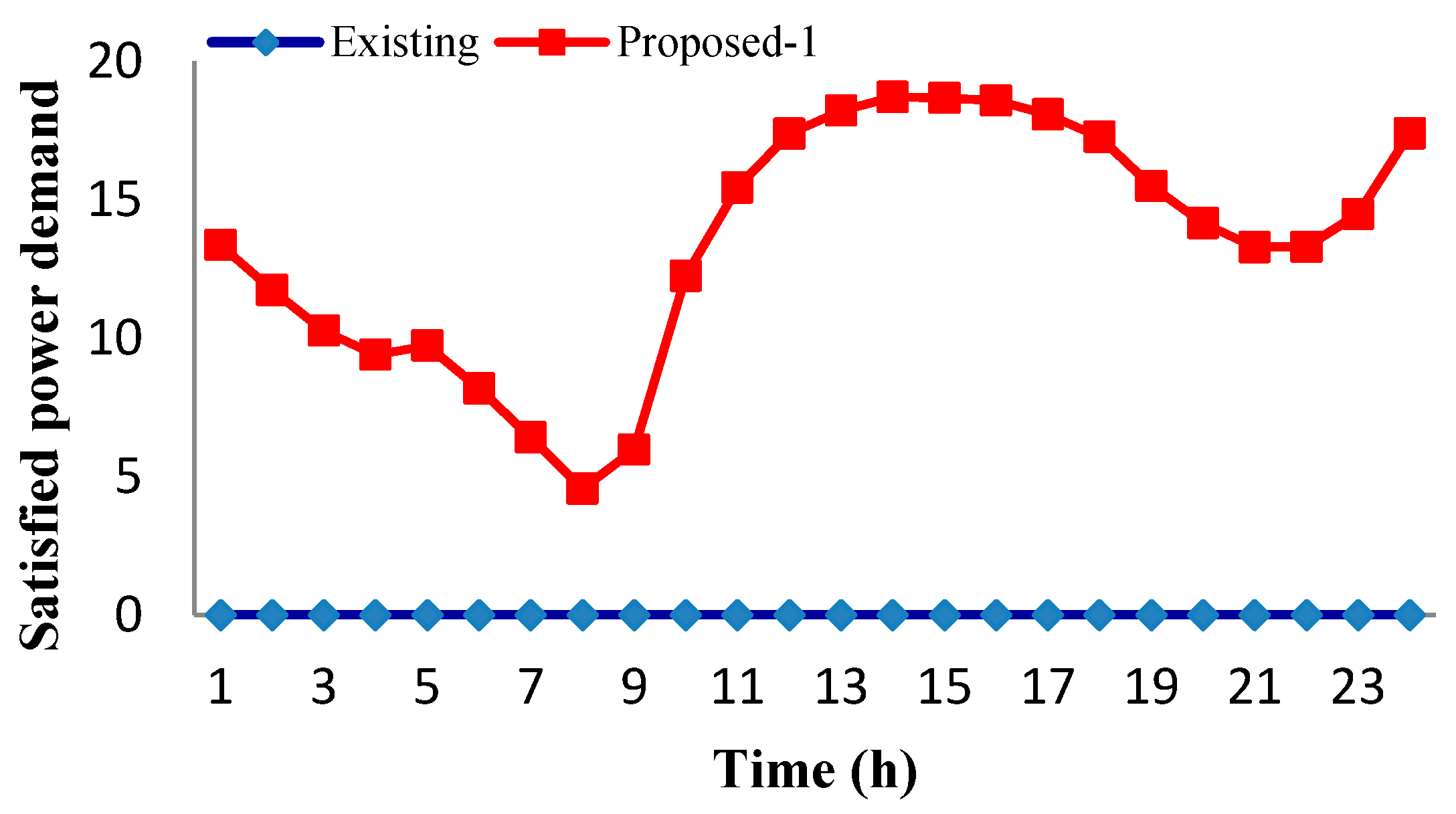
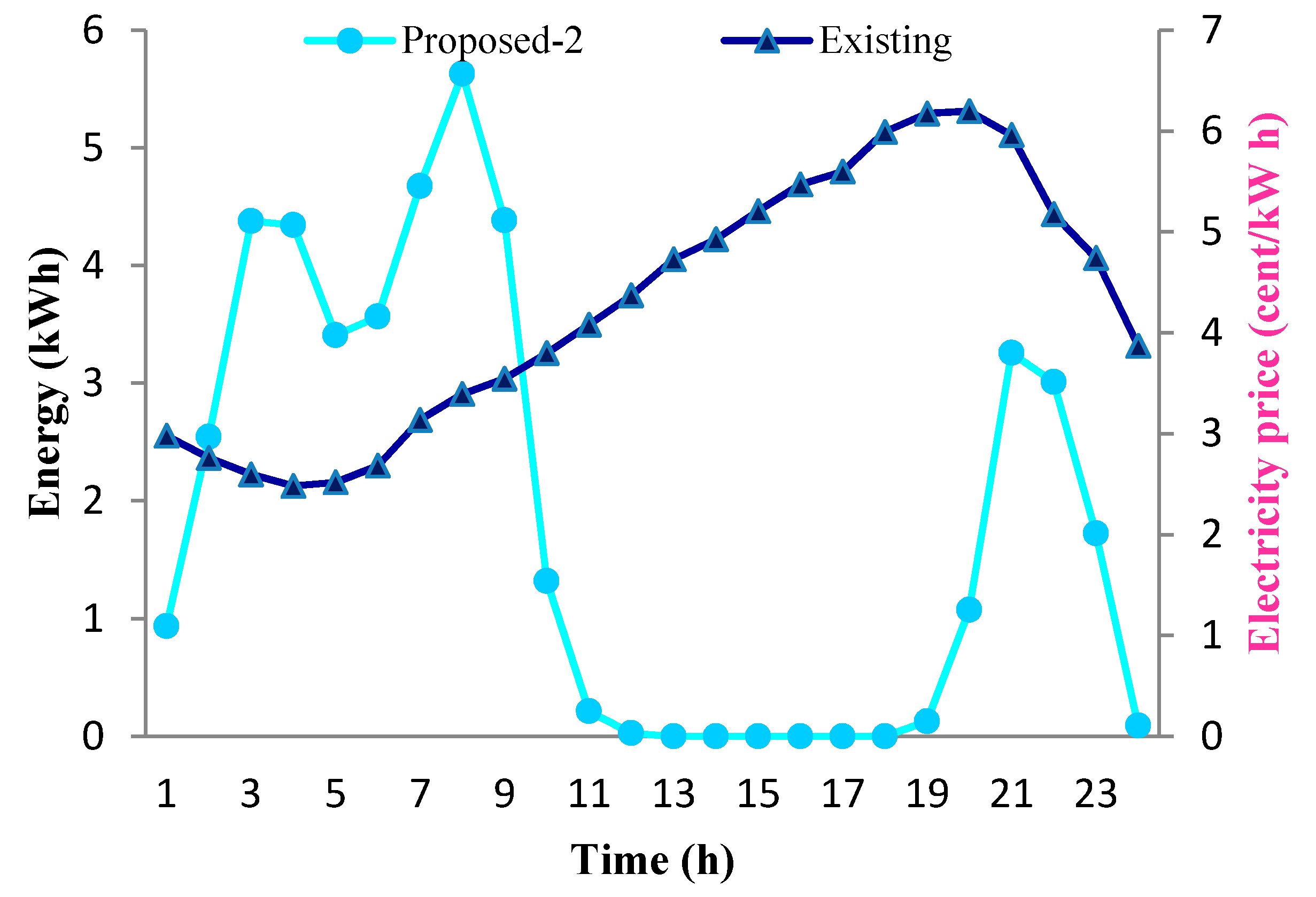


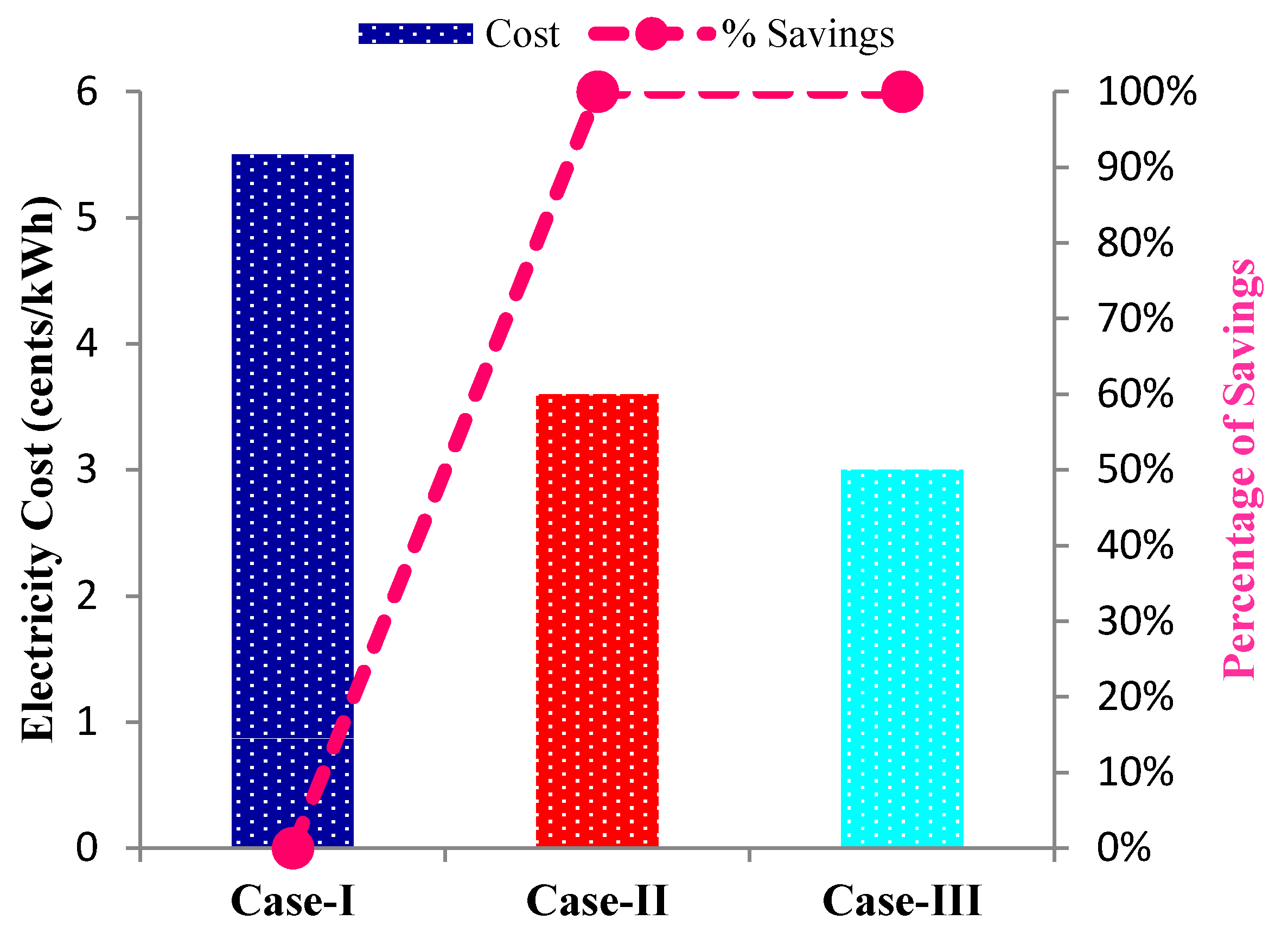




| Parameters | Value | Unit |
|---|---|---|
| Solar PV system | ||
| Total area, A | 125 | m2 |
| Efficiency, ղs | 16 | % |
| Maximum power | 20 | kW |
| Wind generators | ||
| Cut in velocity | 3 | m/s |
| Cut out velocity | 25 | m/s |
| Rated speed | 10 | m/s |
| Maximum power | 20 | kW |
| Battery | ||
| Initial energy level, BLo | 10 | kWh |
| Maximum energy level, BLmax | 30 | kWh |
| Minimum energy level, BLmin | 5 | kWh |
| Energy capacity | 30 | kWh |
| Total hour | 24 | h |
| Total day | 7 | d |
| Total user | 20 | |
| Total iteration | 10 | |
| Energy cost | 0.072 | €/kWh |
| Scenarios | Energy (kWh) | Cost (EUR) | % Saving |
|---|---|---|---|
| Existing | 77 | 5.50 | 0 |
| Proposed 1 | 50 | 3.60 | 35 |
| Scenarios | Satisfied Power Demand | % Saving |
|---|---|---|
| Existing | 0 | 0 |
| Proposed 1 | 16 | 18 |
| Scenarios | Energy (kWh) | Cost (EUR) | % Saving |
|---|---|---|---|
| Existing | 50 | 3.60 | 0 |
| Proposed 2 | 42 | 3.00 | 45 |
| Scenarios | Satisfied Power Demand | % Saving |
|---|---|---|
| Existing | 0 | 0 |
| Proposed 2 | 20 | 22.5 |
| Cases | Energy (kWh) | Cost (EUR) | % Saving |
|---|---|---|---|
| Case I | 77 | 5.50 | 0 |
| Case II | 50 | 3.60 | 35 |
| Case III | 42 | 3.00 | 45 |
| Cases | Energy (kWh) | Cost (EUR) |
|---|---|---|
| Case I | 77 | 5.50 |
| Case II | 50 | 3.60 |
| Case III | 42 | 3.00 |
| Scenarios | Energy (kWh) | Cost (EUR) |
|---|---|---|
| Scenario 1 | 3.85 | 0.27 |
| Scenario 2 | 2.50 | 0.18 |
| Scenario 3 | 2.10 | 0.15 |
| Cases | Satisfied Power Demand | % Saving |
|---|---|---|
| Case I | 0 | 0 |
| Case II | 16 | 18 |
| Case III | 20 | 22.5 |
© 2020 by the authors. Licensee MDPI, Basel, Switzerland. This article is an open access article distributed under the terms and conditions of the Creative Commons Attribution (CC BY) license (http://creativecommons.org/licenses/by/4.0/).
Share and Cite
Rashid, M.M.U.; Granelli, F.; Hossain, M.A.; Alam, M.S.; Al-Ismail, F.S.; Karmaker, A.K.; Rahaman, M.M. Development of Home Energy Management Scheme for a Smart Grid Community. Energies 2020, 13, 4288. https://doi.org/10.3390/en13174288
Rashid MMU, Granelli F, Hossain MA, Alam MS, Al-Ismail FS, Karmaker AK, Rahaman MM. Development of Home Energy Management Scheme for a Smart Grid Community. Energies. 2020; 13(17):4288. https://doi.org/10.3390/en13174288
Chicago/Turabian StyleRashid, Md Mamun Ur, Fabrizio Granelli, Md. Alamgir Hossain, Md. Shafiul Alam, Fahad Saleh Al-Ismail, Ashish Kumar Karmaker, and Md. Mijanur Rahaman. 2020. "Development of Home Energy Management Scheme for a Smart Grid Community" Energies 13, no. 17: 4288. https://doi.org/10.3390/en13174288
APA StyleRashid, M. M. U., Granelli, F., Hossain, M. A., Alam, M. S., Al-Ismail, F. S., Karmaker, A. K., & Rahaman, M. M. (2020). Development of Home Energy Management Scheme for a Smart Grid Community. Energies, 13(17), 4288. https://doi.org/10.3390/en13174288









